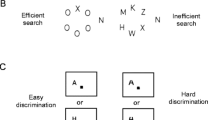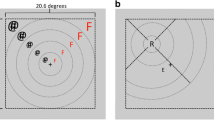Abstract
The Fehrer–Raab effect (simple reaction time is unaffected by metacontrast masking of the test stimulus) seems to imply that a stimulus can trigger a voluntary reaction without reaching a conscious representation. However, it is also possible that the mask triggers the reaction, and that the masked test stimulus causes a focussing of attention from which processing of the mask profits, thus reaching conscious representation earlier. This is predicted by the Weather Station Model of visual masking. Three experiments tested this explanation. Experiment 1 showed that the masked test stimulus caused a temporal shift of the mask. Experiment 2 showed that the reaction in the Fehrer–Raab effect was not exclusively triggered by a conscious representation of the test stimulus: the mask was involved in evoking the reaction. Experiment 3 again revealed a temporal shift of the mask. However, the shift was only about half as large as the Fehrer–Raab effect. The psychometric functions suggested that the observers used two different cues for their temporal order judgments. The results cast doubts on whether judged temporal order yields a direct estimate of the time of conscious perception. Some methodological alternatives are discussed.






Similar content being viewed by others
References
Alpern, M. (1953). Metacontrast. Journal of the Optical Society of America, 43, 648–657.
Bernstein, I. H., Amundson, V. E., & Schurman, D. L. (1973). Metacontrast inferred from reaction time and verbal report: Replication and comment on the Fehrer–Biederman experiment. Journal of Experimental Psychology, 100, 195–201.
Breitmeyer, B. G., & Ganz, L. (1976). Implications of sustained and transient channels for theories of visual pattern masking, saccadic suppression, and information processing. Psychological Review, 83, 1–36.
Cornsweet, T. (1970). Visual perception. New York: Academic.
Efron, R. (1973). Conservation of temporal information by perceptual systems. Perception & Psychophysics, 14, 518–530.
Eriksen, C. W. (1956). Subception: Fact or artifact? Psychological Review, 63, 74–80.
Fehrer, E., & Biederman, I. (1962). A comparison of reaction time and verbal report in the detection of masked stimuli. Journal of Experimental Psychology, 64, 126–130.
Fehrer, E., & Raab, E. (1962). Reaction time to stimuli masked by metacontrast. Journal of Experimental Psychology, 63, 143–147.
Hildreth, J. D. (1973). Bloch’s law and a temporal integration model for simple reaction time to light. Perception & Psychophysics, 14, 421–432.
Lefton, L. A. (1972). Metacontrast: A review. Psychonomic Monograph Supplements, 4, No. 14 (Whole No. 62), 245–255.
Legge, G. (1978). Sustained and transient mechanisms in human vision: Temporal and spatial properties. Vision Research, 18, 69–81.
Münsterberg, H. (1889). Beiträge zur experimentellen Psychologie. Heft 1, Freiburg: Akademische Verlagsbuchhandlung Mohr.
Neisser, U. (1967). Cognitive psychology. New York: Appleton-Century-Crofts.
Neumann, O. (1978). Visuelle Aufmerksamkeit und der Mechanismus des Metakontrasts. [Visual attention and the mechanism of metacontrast.] Report No. 6/1978, Department of Psychology at the Ruhr-University of Bochum, Cognitive Psychology Unit. published as Neumann, O., & Scharlau, I. (2006). Visual attention and the mechanism of metacontrast. Psychological Research (this volume).
Perenin, M. F., & Jeannerod, M. (1978). Visual function within the hemianopic field following early cerebral hemidecortication in man. 1. Spatial localization. Neuropsychologia, 16, 1–13.
Piéron, H. (1923). Les problèmes psycho-physiologiques de la perception du temps. Année Psychologique, 24, 1–25.
Schiller, P. H., & Smith, M. C. (1966). Detection in metacontrast. Journal of Experimental Psychology, 71, 32–39.
Servière, J., Miceli, D., & Galifert, Y. (1977). A psychophysical study of the visual perception of ‘instantaneous’ and ‘durable’. Vision Research, 17, 57–64.
Teichner, W. H., & Krebs, M. J. (1972). Laws of the simple visual reaction time. Psychological Review, 79, 344–358.
Weiskrantz, L., Warrington, E. K., Sanders, M. D., & Marshall, J. (1974). Visual capacity in the hemianopic field following a restricted occipital ablation. Brain, 97, 709–728.
Weiskrantz, L., Cowey, A., & Passingham, C. (1977). Spatial responses to brief stimuli by monkeys with striate cortex ablations. Brain, 100, 655–670.
Weisstein, N. (1972). Metacontrast. In J. Jameson, & L. M. Hurvich (Eds.), Handbook of sensory physiology, Vol. VII/4; Visual psychophysics. Berlin Heidelberg New York: Springer.
Yund, E. W., & Efron, R. (1974). Dichoptic and dichotic micropattern discrimination. Perception & Psychophysics, 15, 383–390.
Editorial References
Ansorge, U., & Heumann, M. (2006). Shifts of visuospatial attention to invisible (metacontrast-masked) singletons: Clues from reaction times and event-related potentials. Advances in Cognitive Psychology (in press).
Ansorge, U., & Neumann, O. (2005). Intentions determine the effect of invisible metacontrast-masked primes: Evidence for top-down contingencies in a peripheral cueing task. Journal of Experimental Psychology: Human Perception and Performance, 31, 762–777.
Aschersleben, G. (1999a). Aufgabenabhängige Datierung von Ereignissen [Task-dependent timing of events]. Aachen: Shaker.
Aschersleben, G. (1999b). Task-dependent timing of perceptual events. In G. Aschersleben, T. Bachmann, & J. Müsseler (Eds.), Cognitive contributions to the perception of spatial and temporal events (pp. 293–318). Amsterdam: Elsevier.
Breitmeyer, B. G., Ogmen, H., & Chen, J. (2004). Unconscious priming by color and form: Different processes and levels. Consciousness and Cognition, 13, 138–157.
Carbone, E. (2006). Motion misperception caused by attentional feedback connections: A neural model simulating the Fröhlich effect. Psychological Research (this volume).
Eimer, M., & Schlaghecken, F. (2003). Response facilitation and inhibition in subliminal priming. Biological Psychology, 64, 7–26.
Jaśkowski, P. (1999). Reaction time and temporal-order judgment as measures of perceptual latency: The problem of dissociations. In G. Aschersleben, T. Bachmann, & J. Müsseler (Eds.), Cognitive contributions to the perception of spatial and temporal events (pp. 265–283). Amsterdam: Elsevier.
Jaśkowski, P., van der Lubbe, R. H. J., Schlotterbeck, E., & Verleger, R. (2002). Traces left on visual selective attention by stimuli that are not consciously identified. Psychological Science, 13, 48–54.
Jaśkowski, P., Skalska, B., & Verleger, R. (2003). How the self controls its “automatic pilot” when processing subliminal information. Journal of Cognitive Neuroscience, 15, 911–920.
Klotz, W., & Neumann, O. (1999). Motor activation without conscious discrimination in metacontrast masking. Journal of Experimental Psychology: Human Perception and Performance, 25, 976–992.
Klotz, W., & Wolff, P. (1995). The effect of a masked stimulus on the response to the masking stimulus. Psychological Research, 58, 92–101.
Lingnau, A., & Vorberg, D. (2005). The time course of response inhibition in masked priming. Perception & Psychophysics, 67, 545–557.
Lleras, A., & Enns, J. T. (2004). Updating a cautionary tale of masked priming: Reply to Klapp (2005). Journal of Experimental Psychology: General, 134, 475–493.
Müsseler, J., & Aschersleben, G. (1998). Localizing the first position of a moving stimulus: The Fröhlich effect and an attention-shifting explanation. Perception & Psychophysics, 60, 683–695.
Müsseler, J., & Neumann, O. (1992). Apparent distance reduction with moving stimuli (tandem effect): Evidence for an attentional-shifting model. Psychological Research, 54, 246–266.
Neumann, O. (1990). Direct parameter specification and the concept of perception. Psychological Research, 52, 207–215.
Neumann, O., Esselmann, U., & Klotz, W. (1993). Differential effects of visual-spatial attention on response latency and temporal-order judgment. Psychological Research, 56, 26–34.
Scharlau, I., & Ansorge, U. (2003). Direct parameter specification of an attention shift: Evidence from perceptual latency priming. Vision Research, 43, 1351–1363.
Scharlau, I., & Horstmann, G. (2006). Perceptual latency priming and illusory line motion: Facilitation by gradients of attention? Advances in Cognitive Psychology (this volume).
Scharlau, I., & Neumann, O. (2003a). Perceptual latency priming by masked and unmasked stimuli: Evidence for an attentional explanation. Psychological Research, 67, 184–197.
Scharlau, I., & Neumann, O. (2003b). Temporal parameters and time course of perceptual latency priming. Acta Psychologica, 113, 185–203.
Schlaghecken, F., & Sisman, R. (2005). Low-level motor inhibition in children: Evidence from the negative compatibility effect. Advances in Experimental Psychology (in press).
Skalska, B., Jaśkowski, P., & van der Lubbe, R. H. J. (2006). The role of direct parameter specification and attentional capture in near-threshold priming of motor reactions. Advances in Experimental Psychology (in press).
Steglich, C., & Neumann, O. (2000). Temporal, but not spatial, context modulates a masked prime’s effect on temporal order judgment, but not on response latency. Psychological Research, 63, 36–47.
Vorberg, D., Mattler, U., Heinecke, A., Schmidt, T., & Schwarzbach, J. (2003). Different time courses for visual perception and action priming. Proceedings of the National Academy of Sciences (USA), 100, 6275–6280.
Author information
Authors and Affiliations
Corresponding author
Rights and permissions
About this article
Cite this article
Neumann, O., Scharlau, I. Experiments on the Fehrer–Raab effect and the ‘Weather Station Model’ of visual backward masking. Psychological Research 71, 667–677 (2007). https://doi.org/10.1007/s00426-006-0055-5
Received:
Accepted:
Published:
Issue Date:
DOI: https://doi.org/10.1007/s00426-006-0055-5




